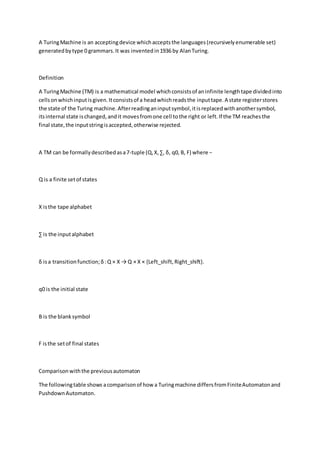
TOA.docx
- 1. A TuringMachine is an acceptingdevice whichacceptsthe languages(recursivelyenumerable set) generatedbytype 0 grammars.It was inventedin1936 by AlanTuring. Definition A TuringMachine (TM) is a mathematical model whichconsistsof aninfinite lengthtape dividedinto cellsonwhichinputisgiven.Itconsistsof a headwhichreadsthe inputtape.A state registerstores the state of the Turing machine.Afterreadinganinputsymbol,itisreplacedwithanothersymbol, itsinternal state ischanged,andit movesfromone cell tothe right or left.If the TM reachesthe final state,the inputstringisaccepted,otherwise rejected. A TM can be formallydescribedasa7-tuple (Q,X,∑, δ, q0, B, F) where − Q is a finite setof states X isthe tape alphabet ∑ is the inputalphabet δ isa transitionfunction;δ:Q × X → Q × X × {Left_shift,Right_shift}. q0 is the initial state B is the blanksymbol F isthe setof final states Comparisonwiththe previousautomaton The followingtable shows acomparisonof how a Turingmachine differsfromFiniteAutomatonand PushdownAutomaton.
- 2. Machine Stack Data Structure Deterministic? Finite Automaton N.A Yes PushdownAutomaton Last In FirstOut(LIFO) No TuringMachine Infinite tape Yes Example of Turingmachine Turingmachine M = (Q,X, ∑, δ, q0, B, F) with Q = {q0, q1, q2, qf} X = {a,b} ∑ = {1} q0 = {q0} B = blanksymbol F = {qf } δ isgivenby− Tape alphabetsymbol PresentState ‘q0’ PresentState ‘q1’ PresentState ‘q2’ a 1Rq1 1Lq0 1Lqf b 1Lq2 1Rq1 1Rqf Here the transition1Rq1 impliesthatthe write symbol is1,the tape movesright,and the nextstate isq1. Similarly,the transition1Lq2 impliesthatthe write symbol is1,the tape movesleft,andthe nextstate isq2. Time and Space Complexityof aTuringMachine For a Turing machine,the time complexityreferstothe measure of the numberof timesthe tape moveswhenthe machine isinitializedforsome inputsymbolsandthe space complexityisthe numberof cellsof the tape written. Time complexityall reasonable functions−
- 3. T(n) = O(nlogn) TM's space complexity− S(n) = O(n) AutomataTutorial AutomataTutorialTheoryof AutomataFinite AutomataTransitionDiagramTransition TableDFAExamplesof DFANFAExamplesof NFAEliminatingε TransitionsConversionfromNFA to DFAConversionfromNFA withεto DFAMinimizationof DFA RegularExpression RegularExpressionExamplesof RegularExpressionConversionof REto FAArden'sTheoremMoore MachineMealyMachineConversionfromMealymachine toMoore machineConversionfromMoore machine toMealy machine CFG Context-free GrammarDerivationDerivationTreeAmbiguityinGrammarUnambiguous GrammarSimplificationof CFGChomsky'sNormal Form(CNF)GreibachNormal Form(GNF) PDA PushdownAutomataPDA AcceptanceNon-deterministicPushdownAutomataCFGtoPDA Conversion TuringMachine AutomataTuringMachine openlinkBasicModel of TuringmachineLanguage acceptedbyTuring machineExample of TMIntroductiontoUndecidabilityUndecidable ProblemaboutTMPost Correspondence ProblemChomskyHierarchyJavaTpoint Next→← Prev TuringMachine
- 4. Turingmachine wasinventedin1936 byAlanTuring.It is an acceptingdevice whichaccepts Recursive Enumerable Language generatedbytype 0grammar. There are variousfeaturesof the Turingmachine: It has an external memorywhichremembersarbitrarylongsequence of input. It has unlimitedmemorycapability. The model hasa facilitybywhichthe inputatleftor righton the tape can be readeasily. The machine can produce a certainoutputbasedon itsinput.Sometimesitmaybe requiredthatthe same inputhas to be usedto generate the output.Sointhismachine,the distinctionbetweeninput and outputhas beenremoved.Thusacommon setof alphabetscanbe usedforthe Turing machine. Formal definitionof Turingmachine A Turingmachine can be definedasacollectionof 7 components: Q: the finite setof states ∑: the finite setof inputsymbols T: the tape symbol q0: the initial state F: a set of final states B: a blanksymbol usedasa endmarkerfor input δ: a transitionormappingfunction. The mappingfunctionshowsthe mappingfromstatesof finite automataandinputsymbol onthe tape to the nextstates,external symbolsandthe directionformovingthe tape head.Thisisknown as a triple or a program forturingmachine. (q0, a) → (q1, A,R) That meansinq0 state,if we readsymbol 'a' thenit will goto state q1, replaceda byX and move aheadright(Rstandsfor right).
- 5. Example: ConstructTM for the language L ={0n1n} where n>=1. Solution: We have alreadysolvedthisproblembyPDA.InPDA,we have a stack to rememberthe previous symbol.The mainadvantage of the Turingmachine iswe have a tape headwhichcan be moved forwardor backward,and the inputtape can be scanned. The simple logicwhichwe will applyisreadouteach '0' mark itby A and thenmove aheadalong withthe inputtape and findout1 convertitto B. Now,repeatthisprocessforall a's andb's. Nowwe will see howthisturingmachine workfor0011. The simulationfor0011 can be shownas below: or 0011 can be shownas below: TuringMachine Now,we will see howthisturingmachine will worksfor0011. Initially,state isq0and headpointsto 0 as: TuringMachine The move will be δ(q0,0) = δ(q1,A,R) whichmeansitwill goto state q1, replaced0 by A andhead will move tothe rightas:
- 6. TuringMachine The move will be δ(q1,0) = δ(q1,0, R) whichmeansitwill notchange any symbol,remaininthe same state and move to the rightas: TuringMachine The move will be δ(q1,1) = δ(q2,B, L) whichmeansitwill goto state q2, replaced1 by B and head will move toleftas: TuringMachine Nowmove will be δ(q2,0) = δ(q2,0, L) whichmeansitwill notchange anysymbol,remaininthe same state and move to leftas: TuringMachine The move will be δ(q2,A) = δ(q0,A,R), itmeanswill goto state q0, replacedA by A andheadwill move to the rightas: TuringMachine The move will be δ(q0,0) = δ(q1,A,R) whichmeansitwill goto state q1, replaced0 by A,and head will move torightas: TuringMachine The move will be δ(q1,B) = δ(q1,B, R) whichmeansitwill notchange any symbol,remaininthe same state and move to rightas: TuringMachine The move will be δ(q1,1) = δ(q2,B, L) whichmeansitwill goto state q2, replaced1 by B and head will move toleftas:
- 7. TuringMachine The move δ(q2,B) = (q2,B, L) whichmeansit will notchange anysymbol,remaininthe same state and move toleftas: TuringMachine Nowimmediatelybefore BisA that meansall the 0?s are marketby A. Sowe will move rightto ensure thatno 1 ispresent.The move will be δ(q2,A) =(q0, A,R) whichmeansitwill goto state q0, will notchange anysymbol,andmove to rightas: TuringMachine The move δ(q0,B) = (q3,B, R) whichmeansitwill goto state q3, will notchange any symbol,and move to rightas: TuringMachine The move δ(q3,B) = (q3,B, R) whichmeansitwill notchange any symbol,remaininthe same state and move toright as: TuringMachine The move δ(q3,Δ) = (q4, Δ, R) whichmeansitwill goto state q4 whichis the HALT state and HALT state is alwaysanaccept state for any TM. TuringMachine The same TM can be representedbyTransitionDiagram: